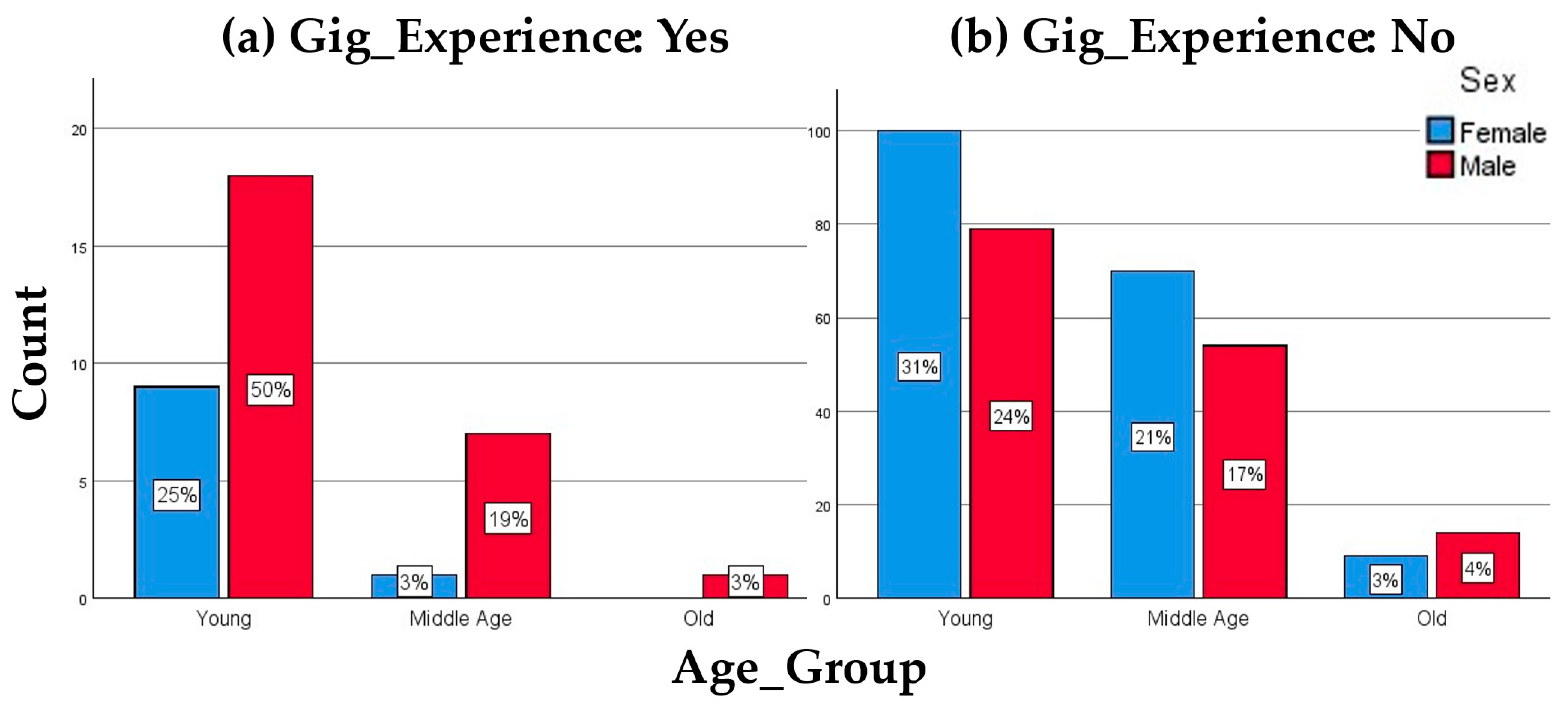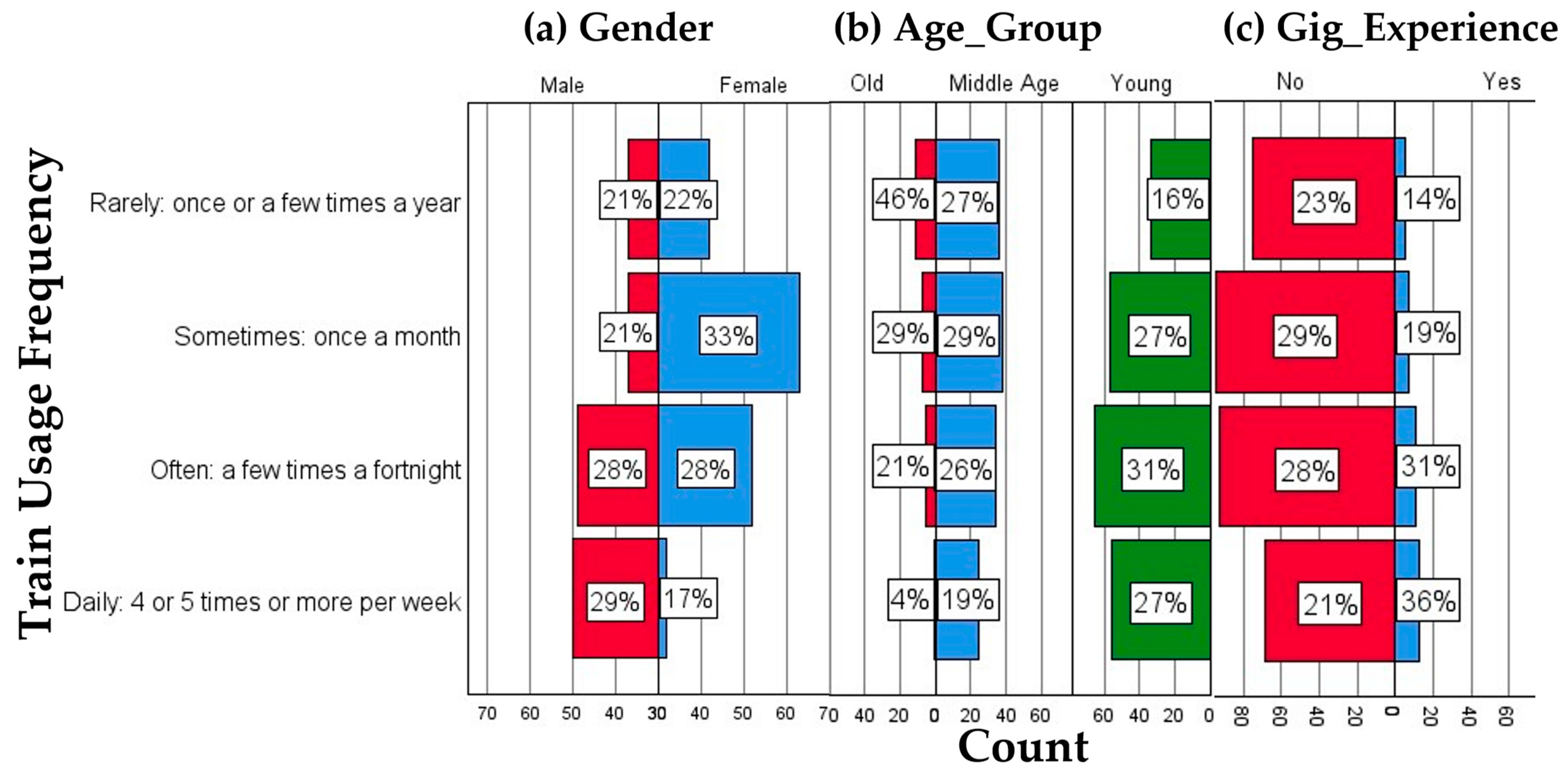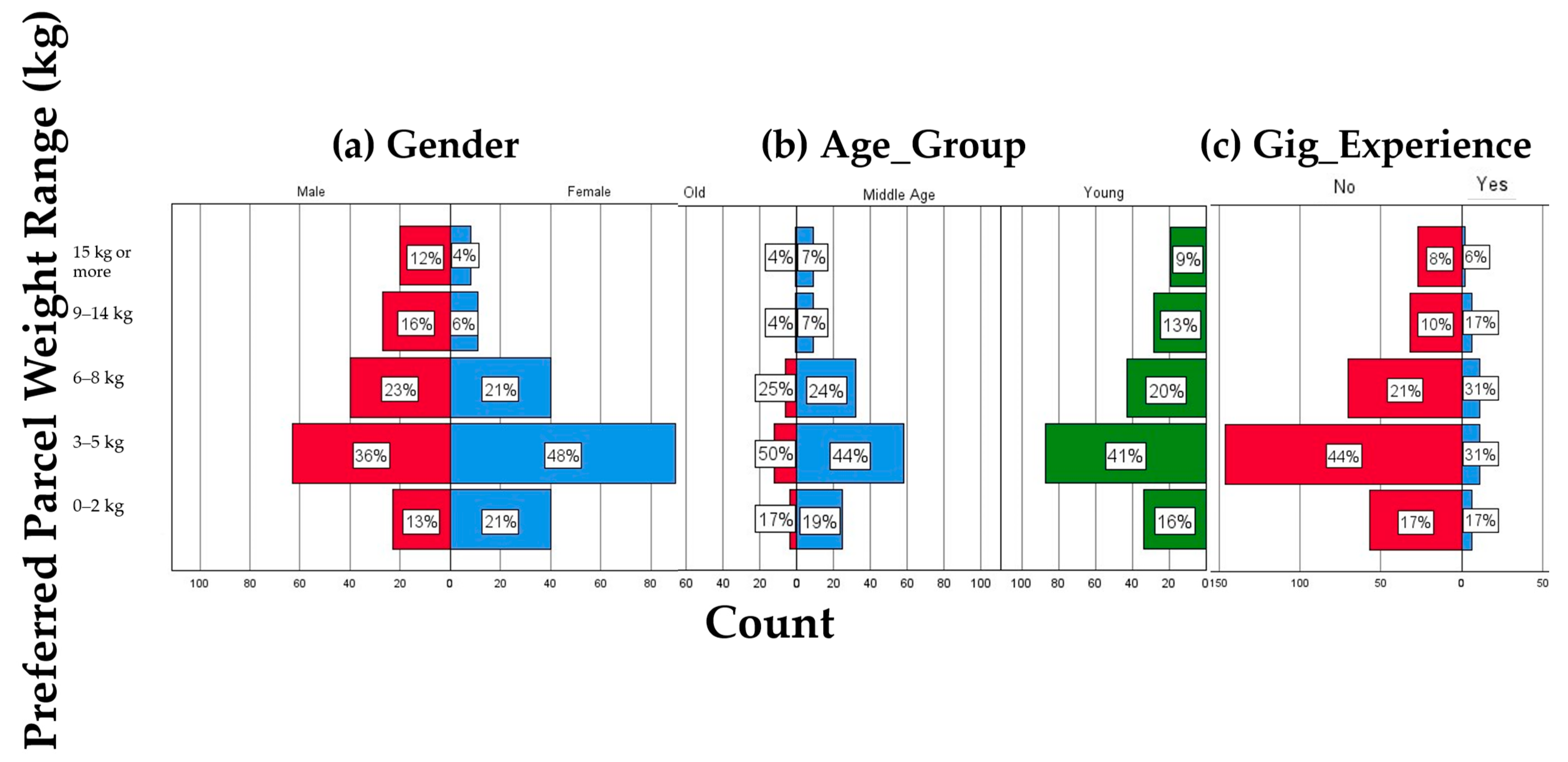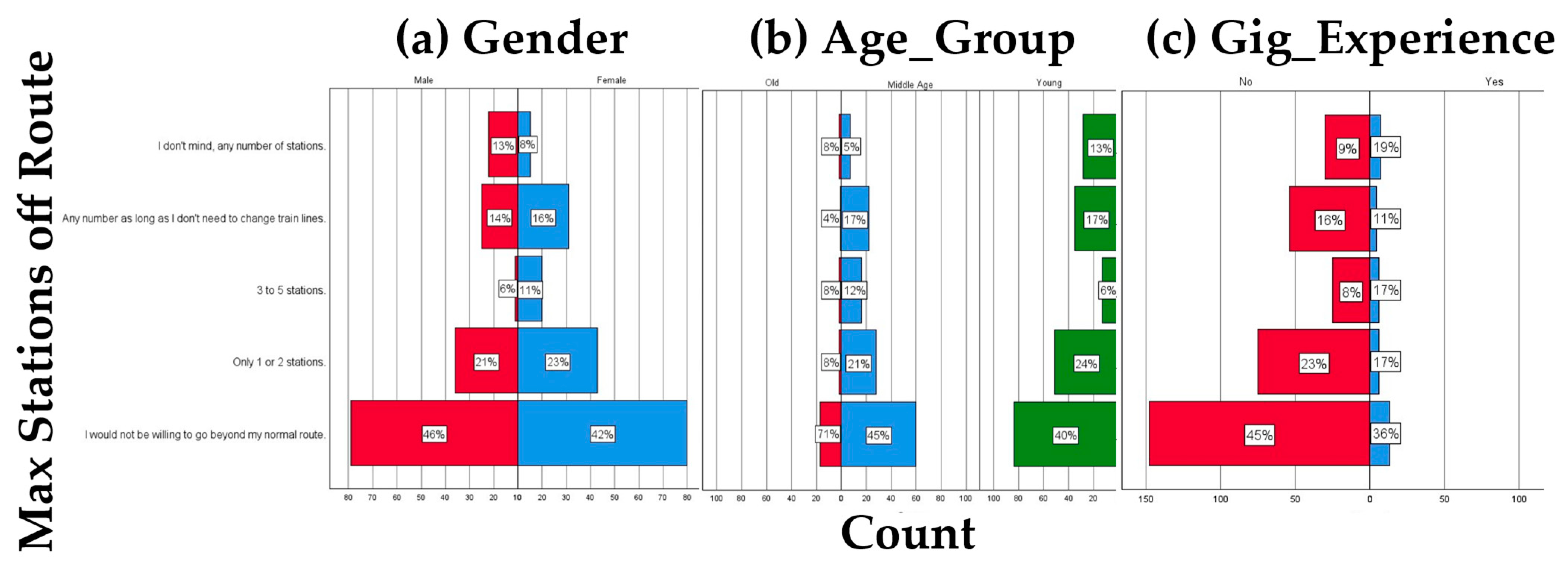Demographic and Operational Factors in Public Transport-Based Parcel Locker Crowdshipping: A Mixed-Methods Analysis
Abstract
1. Introduction
2. Materials and Methods
2.1. Research Design
2.2. Data Collection
2.2.1. Online Survey
2.2.2. Semi-Structured Interviews
2.3. Data Analysis
2.3.1. Quantitative Analysis
2.3.2. Qualitative Analysis
2.4. Ethical Considerations
2.5. Methodological Rigor
3. Results
3.1. Demographic Results
Gig Experience Across Gender and Age
3.2. Train Usage Results
- Gender: Males dominate the frequent train user category (4–5 times or more per week). Females are more evenly distributed across usage frequencies.
- Age Group: Younger participants (18–34) are the most frequent train users, highlighting potential for higher engagement. Middle-aged respondents show moderate usage, while older participants (55+) predominantly use trains rarely or sometimes.
- Gig Experience: Participants with gig experience show higher train usage overall, possibly reflecting a lifestyle conducive to flexible, on-demand work.
3.3. Operational Results
3.3.1. Parcel Handling Preferences
3.3.2. Maximum Distance Willingness from Home or Business
3.3.3. Deviation from Normal Routes
3.3.4. Maximum Parcels Willing to Carry
4. Discussion
4.1. Demographic Insights
4.1.1. Younger Participants as Core Adopters
4.1.2. Gig-Experienced Males: Familiarity Effects
4.1.3. Untapped Female Potential
4.1.4. Limited Engagement Among Older Adults
4.2. Train Usage Patterns
4.3. Operational Preferences
4.3.1. Parcel Handling Preferences
4.3.2. Maximum Distance Willingness from Home/Business Destinations
4.3.3. Deviation from Normal Routes
4.3.4. Maximum Parcels Willing to Carry
4.4. Synthesizing Findings and Alignment with the Literature
4.5. Practical Policy Implications
- Siting Lockers Sensibly: Place lockers near main entrances but away from peak foot-traffic bottlenecks.
- Tiered Compensation: Offer higher pay for heavier loads or slight route deviations to attract gig-experienced couriers.
- Align with Transport Authorities: Collaborate with train/bus operators for integrated ticketing or discounted fares for verified crowdshippers.
- Liability and Insurance: Formalize coverage for lost or damaged goods to reduce participant hesitancy.
- In contrast to ride-hailing services, which typically add extra vehicles to urban roads in response to delivery demands, public transport-based crowdshipping leverages commuter trips that are already taking place. By integrating parcel pickups and drop-offs into existing travel patterns, this approach can potentially reduce overall vehicle kilometers traveled (VKT) and cut emissions. Therefore, while ride-hailing offers on-demand convenience, it does not always yield the environmental benefits associated with public transport-based crowdshipping.
4.6. Limitations and Future Directions
4.6.1. Study Limitations
- Sampling: Our use of Prolific was efficient for a broad, initial sample but may not perfectly represent the general commuter population.
- Self-Reported Behavior: Survey responses regarding weight tolerance or distance willingness may overstate actual behavior.
- Environmental Metrics: While the literature suggests potential emission reductions, we did not collect real-world traffic or pollution data.
- Compensation Unspecified: We discussed incentives qualitatively but did not quantify them. Actual uptake could differ with specific monetary or non-monetary rewards.
4.6.2. Future Research Directions
- Multi-City Comparisons: Investigate whether crowdshipping adoption varies in smaller or differently structured cities, emphasizing the need for comparative analyses across diverse geographical settings (e.g., suburban vs. central business districts).
- Pilot Experiments: Test real-time logistics apps in collaboration with public transport operators, measuring actual route deviations, drop-off reliability, and user satisfaction.
- Regulatory Models: Explore how insurance companies and train operators can formalize coverage.
- Pandemic-Era Shifts: Building on [40], examine post-pandemic travel patterns and changes in e-commerce demand to see if public transport crowdshipping remains viable under shifting conditions.
- Economic Incentives and Labor Segments: While this study primarily examined factors such as parcel weight tolerance, distance willingness, and demographics (age, gender, gig experience), we also collected data on participants’ expected compensation and employment status. A separate, more detailed analysis of these monetary preferences and labor categories (e.g., unemployed vs. employed) will be undertaken in subsequent research. Such inquiries are crucial for determining how compensation structures could affect participation rates and whether certain groups, like unemployed or part-time workers, might be more receptive to flexible crowdshipping tasks.
5. Conclusions
Author Contributions
Funding
Institutional Review Board Statement
Informed Consent Statement
Data Availability Statement
Acknowledgments
Conflicts of Interest
References
- Cheng, R.; Fessler, A.; Nielsen, O.A.; Larsen, A.; Jiang, Y. Assessing the potential impacts of public transport-based crowdshipping: A case study in a central district of Copenhagen. Front. Eng. Manag. 2024, 11, 697–709. [Google Scholar] [CrossRef]
- Ranieri, L.; Digiesi, S.; Silvestri, B.; Roccotelli, M. A review of last mile logistics innovations in an externalities cost reduction vision. Sustainability 2018, 10, 782. [Google Scholar] [CrossRef]
- Morganti, E.; Seidel, S.; Blanquart, C.; Dablanc, L.; Lenz, B. The Impact of E-commerce on Final Deliveries: Alternative Parcel Delivery Services in France and Germany. Transp. Res. Procedia 2014, 4, 178–190. [Google Scholar] [CrossRef]
- Mohri, S.S.; Ghaderi, H.; Van Woensel, T.; Mohammadi, M.; Nassir, N.; Thompson, R.G. Contextualizing alternative delivery points in last mile delivery. Transp. Res. Part E Logist. Transp. Rev. 2024, 192, 103787. [Google Scholar] [CrossRef]
- Gatta, V.; Marcucci, E.; Nigro, M.; Patella, S.M.; Serafini, S. Public Transport-Based Crowdshipping for Sustainable City Logistics: Assessing Economic and Environmental Impacts. Sustainability 2019, 11, 145. [Google Scholar] [CrossRef]
- Mohri, S.S.; Ghaderi, H.; Nassir, N.; Thompson, R.G. Crowdshipping for sustainable urban logistics: A systematic review of the literature. Transp. Res. Part E Logist. Transp. Rev. 2023, 178, 103289. [Google Scholar] [CrossRef]
- Wyrowski, A.; Boysen, N.; Briskorn, D.; Schwerdfeger, S. Public transport crowdshipping: Moving shipments among parcel lockers located at public transport stations. OR Spectr. 2024, 46, 873–907. [Google Scholar] [CrossRef]
- Zhou, F.; Zhang, J. Freight transport mode based on public transport: Taking parcel delivery by subway as an example. In Proceedings of the 6th International Conference on Transportation Engineering (ICTE 2019), Chengdu, China, 20–22 September 2019; American Society of Civil Engineers (ASCE): Reston, VA, USA, 2020; pp. 745–754. [Google Scholar] [CrossRef]
- Buldeo Rai, H.; Verlinde, S.; Merckx, J.; Macharis, C. Crowd logistics: An opportunity for more sustainable urban freight transport? Eur. Transp. Res. Rev. 2017, 9, 39. [Google Scholar] [CrossRef]
- Shaheen, S.; Chan, N. Mobility and the sharing economy: Potential to facilitate the first-and last-mile public transit connections. Built Environ. 2016, 42, 573–588. [Google Scholar] [CrossRef]
- Schmidt, J.; Tilk, C.; Irnich, S. Using public transport in a 2-echelon last-mile delivery network. Eur. J. Oper. Res. 2024, 317, 827–840. [Google Scholar] [CrossRef]
- Nieto-Isaza, S.; Fontaine, P.; Minner, S. The value of stochastic crowd resources and strategic location of mini-depots for last-mile delivery: A Benders decomposition approach. Transp. Res. Part B Methodol. 2022, 157, 62–79. [Google Scholar] [CrossRef]
- Nguyen, N.; Tran, T.H.H.; Luu, T.T.D.; Vu, T.D. Crowdshippers’ intentions to continue participating in last-mile delivery: A study in Vietnam. Asian J. Shipp. Logist. 2023, 39, 48–56. [Google Scholar] [CrossRef]
- Roig-Costa, O.; Miralles-Guasch, C.; Marquet, O. Disrupted intermodality: Examining adaptation strategies to public transport e-scooter bans in Barcelona. Int. J. Sustain. Transp. 2024, 18, 1072–1085. [Google Scholar] [CrossRef]
- Evangelista, P.; McKinnon, A.; Sweeney, E. Technology adoption in small and medium-sized logistics providers. Ind. Manag. Data Syst. 2013, 113, 967–989. [Google Scholar] [CrossRef]
- Mohri, S.S.; Nassir, N.; Thompson, R.G.; Lavieri, P.S.; Ghaderi, H. Crowd-shipping systems with public transport passengers: Operational planning. Transp. Res. Part E Logist. Transp. Rev. 2025, 194, 103916. [Google Scholar] [CrossRef]
- Fessler, A.; Haustein, S.; Thorhauge, M. Drivers and barriers in adopting a crowdshipping service: A mixed-method approach based on an extended theory of planned behaviour. Travel Behav. Soc. 2024, 35, 100747. [Google Scholar] [CrossRef]
- Lu, F.; Du, Z.; Wang, Z.; Wang, L.; Wang, S. Towards Enhancing the Crowdsourcing Door-to-Door Delivery: An Effective Model in Beijing. J. Ind. Manag. Optim. 2025, 21, 2371–2395. [Google Scholar] [CrossRef]
- Wood, A.J.; Graham, M.; Lehdonvirta, V.; Hjorth, I. Good Gig, Bad Gig: Autonomy and Algorithmic Control in the Global Gig Economy. Work. Employ. Soc. 2019, 33, 56–75. [Google Scholar] [CrossRef]
- Morse, J.M. Approaches to qualitative-quantitative methodological triangulation. Nurs. Res. 1991, 40, 120–123. [Google Scholar] [CrossRef]
- Morse, J.M.; Barrett, M.; Mayan, M.; Olson, K.; Spiers, J. Verification Strategies for Establishing Reliability and Validity in Qualitative Research. Int. J. Qual. Methods 2002, 1, 13–22. [Google Scholar] [CrossRef]
- Norman, G. Likert scales, levels of measurement and the ‘laws’ of statistics. Adv. Health Sci. Educ. 2010, 15, 625–632. [Google Scholar] [CrossRef]
- Palan, S.; Schitter, C. Prolific.ac—A subject pool for online experiments. J. Behav. Exp. Financ. 2018, 17, 22–27. [Google Scholar] [CrossRef]
- Mauceri, S. Integrating quality into quantity: Survey research in the era of mixed methods. Qual. Quant. 2016, 50, 1213–1231. [Google Scholar] [CrossRef]
- Sefcik, J.S.; Hathaway, Z.; DiMaria-Ghalili, R.A. When snowball sampling leads to an avalanche of fraudulent participants in qualitative research. Int. J. Older People Nurs. 2023, 18, e12572. [Google Scholar] [CrossRef]
- Malapane, T.A.; Ndlovu, N.K. Assessing the Reliability of Likert Scale Statements in an E-Commerce Quantitative Study: A Cronbach Alpha Analysis Using SPSS Statistics. In Proceedings of the 2024 Systems and Information Engineering Design Symposium (SIEDS 2024), Charlottesville, VA, USA, 3 May 2024; pp. 90–95. [Google Scholar] [CrossRef]
- Nowell, L.S.; Norris, J.M.; White, D.E.; Moules, N.J. Thematic Analysis: Striving to Meet the Trustworthiness Criteria. Int. J. Qual. Methods 2017, 16, 1–13. [Google Scholar] [CrossRef]
- Corrigan, O. Empty ethics: The problem with informed consent. Sociol. Health Illn. 2003, 25, 768–792. [Google Scholar] [CrossRef]
- Ham, M.; Jones, N.; Mansell, I.; Northway, R.; Price, L.; Walker, G. ‘I’m a researcher!’ Working together to gain ethical approval for a participatory research study. J. Learn. Disabil. 2004, 8, 397–407. [Google Scholar] [CrossRef]
- Kallio, H.; Pietilä, A.-M.; Johnson, M.; Kangasniemi, M. Systematic methodological review: Developing a framework for a qualitative semi-structured interview guide. J. Adv. Nurs. 2016, 72, 2954–2965. [Google Scholar] [CrossRef]
- Gatta, V.; Marcucci, E.; Nigro, M.; Serafini, S. Sustainable urban freight transport adopting public transport-based crowdshipping for B2C deliveries. Eur. Transp. Res. Rev. 2019, 11, 13. [Google Scholar] [CrossRef]
- Adermon, A.; Hensvik, L. Gig-jobs: Stepping stones or dead ends? Labour Econ. 2022, 76, 102171. [Google Scholar] [CrossRef]
- Min, X.; Bansal, P. The gender productivity gap in the ride-hailing market. Travel Behav. Soc. 2023, 32, 100569. [Google Scholar] [CrossRef]
- Pourrahmani, E.; Jaller, M. Crowdshipping in last mile deliveries: Operational challenges and research opportunities. Socio-Econ. Plan. Sci. 2021, 78, 101063. [Google Scholar] [CrossRef]
- Dunn, M. Making gigs work: Digital platforms, job quality and worker motivations. New Technol. Work. Employ. 2020, 35, 232–249. [Google Scholar] [CrossRef]
- Healy, J.; Pekarek, A.; Vromen, A. Sceptics or supporters? Consumers’ views of work in the gig economy. New Technol. Work. Employ. 2020, 35, 1–19. [Google Scholar] [CrossRef]
- Zhang, M.; Cheah, L. Prioritizing Outlier Parcels for Public Transport-Based Crowdshipping in Urban Logistics. Transp. Res. Rec. 2024, 2678, 601–612. [Google Scholar] [CrossRef]
- Galkin, A.; Schlosser, T.; Capayova, S.; Takacs, J.; Kopytkov, D. Attitudes of Bratislava citizens to be a crowd-shipping non-professional courier. Transp. Res. Procedia 2021, 55, 152–158. [Google Scholar] [CrossRef]
- Bathke, H.; Munch, C. From Occasional to Active Crowdshippers: The Significance of Couriers’ Characteristics. IEEE Trans. Eng. Manag. 2024, 71, 12094–12109. [Google Scholar] [CrossRef]
- Melo, S.; Ferreira, L.d.J. Pandemic Lasting Effects on Freight Networks: Challenges and Directions from Cities and Industry. In Transport and Pandemic Experiences; Emerald Publishing Limited: Leeds, UK, 2022; Volume 17, pp. 257–269. [Google Scholar] [CrossRef]





Disclaimer/Publisher’s Note: The statements, opinions and data contained in all publications are solely those of the individual author(s) and contributor(s) and not of MDPI and/or the editor(s). MDPI and/or the editor(s) disclaim responsibility for any injury to people or property resulting from any ideas, methods, instructions or products referred to in the content. |
© 2025 by the authors. Licensee MDPI, Basel, Switzerland. This article is an open access article distributed under the terms and conditions of the Creative Commons Attribution (CC BY) license (https://creativecommons.org/licenses/by/4.0/).
Share and Cite
Maleki, M.; Rayburg, S.; Glackin, S. Demographic and Operational Factors in Public Transport-Based Parcel Locker Crowdshipping: A Mixed-Methods Analysis. Logistics 2025, 9, 55. https://doi.org/10.3390/logistics9020055
Maleki M, Rayburg S, Glackin S. Demographic and Operational Factors in Public Transport-Based Parcel Locker Crowdshipping: A Mixed-Methods Analysis. Logistics. 2025; 9(2):55. https://doi.org/10.3390/logistics9020055
Chicago/Turabian StyleMaleki, Mohammad, Scott Rayburg, and Stephen Glackin. 2025. "Demographic and Operational Factors in Public Transport-Based Parcel Locker Crowdshipping: A Mixed-Methods Analysis" Logistics 9, no. 2: 55. https://doi.org/10.3390/logistics9020055
APA StyleMaleki, M., Rayburg, S., & Glackin, S. (2025). Demographic and Operational Factors in Public Transport-Based Parcel Locker Crowdshipping: A Mixed-Methods Analysis. Logistics, 9(2), 55. https://doi.org/10.3390/logistics9020055





